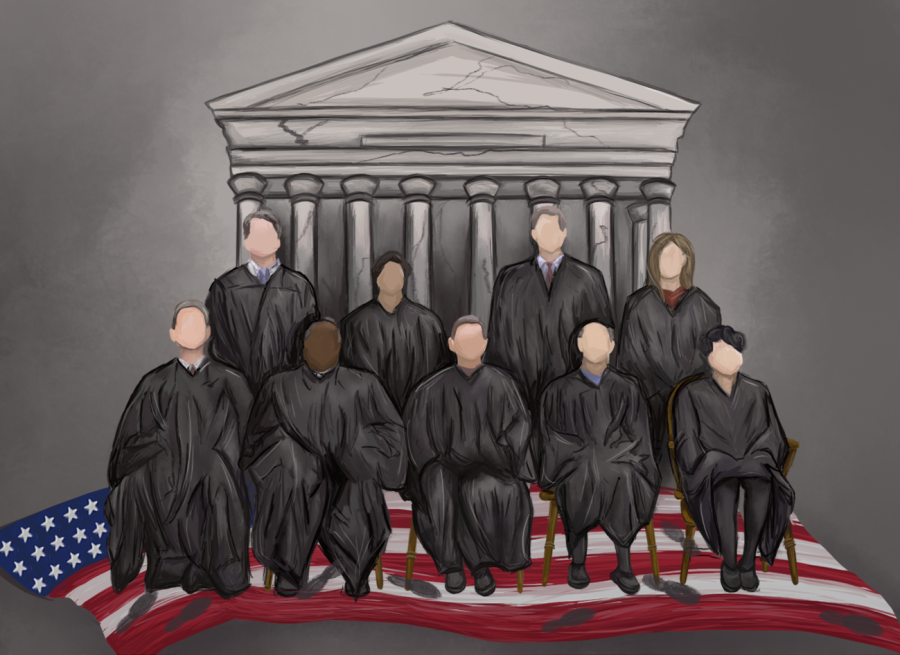The undemocratic third of our democracy
The nine justices are seated on a torn American flag in front of the cracked Supreme Court building. The recent overturn of Roe v. Wade has revealed a deep seated flaw in our democracy, the judicial branch of our government holds too much power.
The Supreme Court is out of control.
Yes, that’s a bold statement, but the cracks within the judicial branch of our government are becoming frighteningly clear with the recent actions of a few reckless justices. After four years of Donald Trump’s presidency and the right wing’s dramatically partisan actions, our country is left with three new justices — a conservative supermajority that divides the Court six to three.
The Supreme Court was never intended to have this much power or to be free of the people’s will.
The recent and popularized case, Dobbs v. Jackson Women’s Health Organization, led to the overturn of the landmark abortion rights case Roe v. Wade, which granted federal protection of abortion. After control of abortion legislation shifted to the state level, abortion has been banned, restricted or threatened in 30 states. Despite most Americans supporting abortion rights, the Court disregarded the privacy and right to equal protection enjoyed by Americans under the 14th amendment.
Conservative justice Samuel Alito wrote the majority opinion, explaining that the basis of the court’s decision rested on the principle of “original intent,” a legal theory that the Constitution should be interpreted by what the Founding Fathers had intended for the country.
It is sheer hypocrisy to back original intent while allowing the Second Amendment to protect guns significantly more deadly than anything in the 1700s. It is also essential to note that the Constitution was written by a room full of rich, white men — a demographic that does not accurately represent our country today. Society continues to grow and advance, and our laws also need to change. Yet, it seems like our government is stuck in the past, psychoanalyzing dead men who won’t have to live with the consequences of the Court’s decisions.
This is not just a problem of partisanship but of a fundamentally flawed political system. The Court holds the power of judicial supremacy, giving its justices the final say in the interpretation of the Constitution — only new Court rulings or Constitutional amendments can overturn its decisions.
Beyond that, the Court has been accumulating power since its inception. For example, the Court only gained the power of judicial review in 1803, when it decided in the case of Marbury v. Madison to give itself the ability to render a law invalid for being unconstitutional. Then, in 1988, Congress reformed Supreme Court jurisdiction by giving it complete discretion over selecting cases from thousands of appeals, allowing the Court to rule on basically any issue they want.
This power is unmatched. A simple majority of five justices allows the court to impose new legal standards for the entire country without any input from the public.
Perhaps the Supreme Court would be more stable if the legislative and executive branches were fully functioning. But with a partisan and gridlocked Congress, the Court has essentially gained free reign over its docket and decisions, and it is only getting bolder.
“In future cases, we should reconsider all of this court’s substantive due process precedents, including Griswold, Lawrence, and Obergefell,” conservative justice Clarence Thomas wrote after the reversal of Roe v. Wade.
This is a direct attack against Americans’ right to contraceptives, private same-sex intercourse and gay marriage. With this threat, it becomes apparent that the Court’s conservative justices are more concerned with reforming the country to align with their beliefs than with the true constitutionality of these cases.
The Supreme Court has stripped federal power away to the point where there is no easy fix. In June alone, the Supreme Court decided on several major cases with votes straight down party lines. As everything from gun control to carbon emissions regulations comes under fire, the country seems to be finally taking notice of this errant third branch of the government.
Unfortunately, there isn’t a clear next step. Any action taken right now would be like applying Band-Aids to bullet wounds. Nothing will provide the instantaneous results that we need. It is the fault of a decaying democracy and inherently flawed political system that allows nine people to make decisions for the entire country at their own whims, unable to be held accountable to the people. Liberals and conservatives have benefited from the ruthless efficiency of the Supreme Court as it allowed them to bypass Congress and its tedious negotiations. But democracy is all about the messy votes and hearing the people’s voice — something the Court takes away.
Solving the problem is more than addressing the symptoms; it requires examining the root cause of our political disarray. Any proposed suggestions — from increasing the number of justices to instating term limits — are only temporary solutions. There’s merit to considering these changes, but we must remember that these are not permanent fixes. Reforming the Court is not just about making it more liberal or conservative but ensuring that justices cannot act as all-powerful legislators removed from the confines of democracy.
It may seem counterintuitive to advocate for voting when the justices in question are not elected by any ballot, but it remains the cornerstone of our democracy and one of the most effective ways to control the Court. We have a political system of checks and balances — an imperfect and imbalanced system, but a functioning one. Congress has the power to check the Supreme court, but it remains ineffective as long as the legislative branch is gridlocked. From impeaching a justice to amending the Constitution, executing most checks on the branch requires at least a two-thirds vote. The public can’t do much to control the Court, but electing politicians willing to overturn and fight its rulings can indirectly exert the people’s will.
Beyond Congress, state elections have become some of the most critical legislative powers in curbing the influence of the Supreme Court, further proving the importance of voting. As seen in the Dobbs case, states are often handed power when the Supreme Court strips it from the federal level. Even when the Court directly attacks state law, such as New York’s gun control law, the state government has a wide range of options to respond, such as passing laws to work around Court rulings.
Regardless of how our government chooses to resist the judicial branch, it can only succeed with the support of the people. So let us not be lulled into complacency or a false sense of security. Nine justices should not determine the fate of an entire country.





